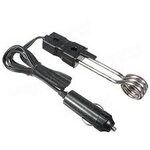Thayne
Member level 3

I want to hook two, 5V~ (output) phone chargers in series to get 12V~ to power a soldering iron I am making. I searched this online, but not too satisfied with what I came across. A lot of the posts of advice were by people super concerned about exact voltages and amps. I know I can power the iron with a single 5V charger, but I would like the extra power. I don't need to worry too much about frying the device as it is just copper and steel. I guess my only concern is that the electronics of the charges do not get fried.
Thanks!
Thanks!




